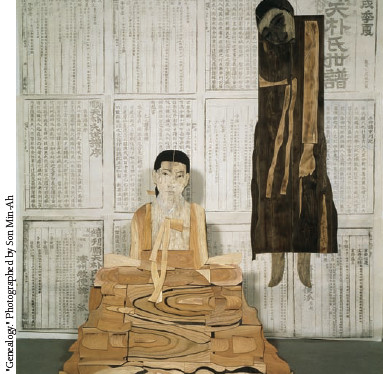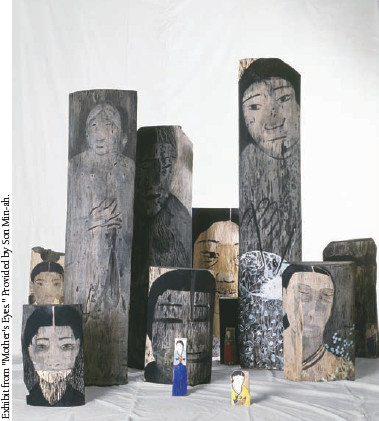
Suk-Nam Yun started drawing after having her mother as a role model. She started by creating works that have relevance to feminism and at the age of 40 she officially started her career as an artist and was awarded with many awards. The Sungkyun Times (The SKT) interviewed Yun who is a highly respected artist and thought she could give a better insight to our students of SungKyunKwan University, having been a part of our school even for a short period of time.
Could you please introduce yourself to our readers?
Hello, I am Suknam Yun, an installation artist. I was born in Manchuria when Korea was still under Japanese colonization, and I came back to Korea when I was six. It has always been my dream to become an artist, but I could not realize that dream due to various circumstances. I started working as soon as I graduated high school, and I only attended college for one year due to financial reasons. I actually studied Seoye, Korean calligraphy, under the guidance of Doojin Park, but I decided that I was more suited for art, so I started installation art when I was in my 30's.
You said it has always been your dream to become an artist, but you attended Sunkyunkwan University as an English literature major. Why was that?
Well, my dream was to be an artist, but Sunkyunkwan University did not have an art school at the time. It did, however, offer night classes, so I attended those because I could not take day classes due to my work. So I decided to be an English literature major because they had courses at night classes. However, as I attended night classes, I thought that it did not fit my idea of a university, as only one professor gave lectures to a class of 60 to 70 students. I could not learn properly under those circumstances, and the tuition was also too expensive for me at the time. So I dropped out of college altogether. To be honest, literature has always fascinated me. I actually won a Presidential Award for literature when I was in middle school, so I do think I have a talent for it. Nonetheless, I consider literature to simply be a spice in my life. If I had continued to pursue it, I probably would not be here right now, practicing the art that I love so much.
Please tell us what art means to you.
When I first started art, I did not just think, “Oh, I want to make a living out my hobby.” I started art in order to find my purpose in life. Honestly speaking, I did not know what I was living for before that. Once I started to question my reason for living, I realized that I could prove that I existed through art. That is why my art represents my life. However, that is not entirely true. I was actually afraid to tell my own life story, to have my whole life exposed to others so openly. That is why I started with telling the story of my mother. The exhibition "Mother's Eyes," which started in 1993, was entirely about my mother. Once that was over, I finally felt brave enough to represent my own life story through art, which was the “Pink Room” series. That is why to me, art is something that proves my existence, something that lets other people know that I, Suknam Yun, am here, living.
You have been an artist for a very long time. Is there a specific piece of work that you consider to be a favorite?

As an artist, I cannot have a favorite piece of work, since I have to sell everything I make in order to make a living from it. However, if I really had to choose, I would probably pick "Mother || Daughter and Son," currently on display in the Gwacheon National Museum of Contemporary Art, and “Genealogy,” which is on display in the Fukuoka Art Museum in Japan. I actually still wonder why I sold that. Other than that, I am also fond of the “Pink Room” series, but honestly, this is all talk of the past. Truth to be told, my favorite piece of work is whatever work it is that I am currently working on, since once I sell a piece, I inevitably end up forgetting about it, or intentionally not thinking about it. That is why right now, if you asked me what my favorite piece was, it would be “1,025: With or Without Person.” It is about an old woman who took care of 1,025 abandoned dogs, so I hand-carved 1,025 dogs out of wood and brought them with me whenever I had to attend an exhibit. You can imagine that all that dragging around damaged them quite a bit, so I am currently working on restoring them. I think that is the one work that I can proudly present to others, saying “Yes, this is my work.”
We heard that you were the chairman of an organization called Women's Cultural Art Club. Could you give a brief explanation of what that is?
Well, the Women’s Cultural Art Club is an organization that has been active for around 15 years now, and I have been with them since the very beginning. I felt that I had to help them out, as an artist who specializes in feminist art. It turns out, though, that I was the oldest member there, which is why they decided to elect me as chairman. So I did that for about ten years. As for the organization itself, it works by planning plays, musicals, or other such exhibits that are pertinent to women's history using money collected from active members. They also offer counseling. Fifteen years ago, they even hosted a film festival. However, I have to admit that they have lost relevance. When they first started, women did not have as many rights as they have now. As men and women became more and more equal, the need for such organization to exist has faded throughout the years.
Did you always intend on making feminist art?

Actually when I first started making art, back in 1979, the concept of feminism did not yet exist, at least in Korea. To add to that, the artistic world back then did not accept anything as art except for art in its purest form. Art had to be simply that: art. Any form of art that had to do with politics, or academics, or any other field outside of simply drawing was not considered art, but was rather given a separate category. However, my art told a story, a story that was neither political nor academic. I conveyed a message through art, and that message started being labeled as feminist as the years passed.
What message were you trying to portray to others through your art?

It is quite a simple story really. As I said before, I started by telling the story of my mother. When she was 39 years old, my father passed away, and she had to raise six children by herself. I was a freshman in high school when that happened. So I told her that I would drop out and work in the neighborhood café so I could support us financially, but she refused straight away. She even went to my high school and pleaded to my teachers to let me stay in school. That is the only reason I was able to graduate high school. We were going through a very difficult financial crisis, and we could not even afford to buy rice, but even under such circumstances, my mother wanted me to get proper education. I have never seen her complain about our situation. That is why I respect her immensely, and I believe that what my mother did reflects the hard work and determination of countless other women in that time period, or even throughout our history altogether. My mother became the inspiration for my first private exhibition, “Mother,” which started in April of 1979 and was put on display in October of 1981.
You mentioned the hard work and determination of women throughout history. Could you elaborate on what you mean by that?
Surely today’s generation is not as aware of the hardships that women endured during my days. We lived in a patriarchal society, and women were forced to come to the city and work in factories in order to support their families. At the time, society did not think much of their efforts, but I do believe that this determination represents the strength of women. Compared to the difficulty of working in such factories, the work was not very rewarding, but in the end women also played a key role in the industrialization and development in Korea. I think that was the underlying message that I wanted to convey through my art and my opinions are what society started to call feminissm. And I am perfectly fine with that.
Lastly, do you have any advice for students currently majoring in art at Sungkyunkwan University?

To be able to make a steady living from art alone in Korea is close to a miracle. Of course, some may be able to lead a luxurious lifestyle simply through art, but those are among a handful of people. That is why if you want to truly pursue art as a career, you must not be afraid or reluctant to have one or two side jobs aside from art. You must earn money from another job to spend and invest on art. You cannot do art when penniless, because it does not always bring rewards. Sometimes you will make art, and it will bring you no money, no fame, and no recognition. But that is normal. If you truly, truly want to turn art into your career, then you must first make money to support that dream. That pride, that ambition to be able to call yourself an artist is what I believe to be the foundation of an artist. Without confidence, one cannot achieve anything.
